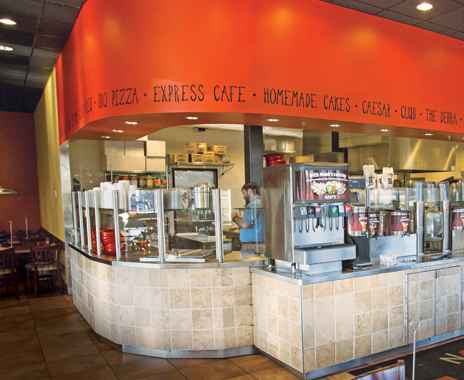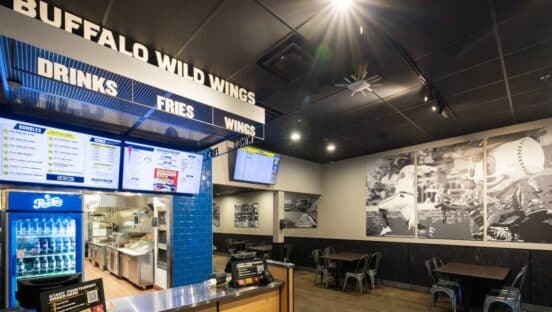Operators are often looking to improve their store throughput, or the efficiency with which they get customers through the restaurant. But at least one industry expert thinks that as they do so, they’re overlooking the business potential of zone merchandising to both speed throughput and boost ticket totals.
Zone merchandising—setting measurable business goals for different areas of the restaurant while considering customers’ needs and behaviors in each—can help operators make every second of their brief interactions with customers count, says Howland Blackiston, principal at Westport, Connecticut–based consultancy King-Casey.
“[Zone merchandising] is an exercise that can be repeated for each zone of the restaurant—from entry to pre-order to lineup,” Blackiston says. “You first have to determine what business objectives you want to achieve in a measurable way in each zone, whether that’s selling more combo meals or speeding order times.”
To properly configure the store to maximize productivity and optimize the customer experience, quick serves must look at consumer behavior in each zone. This strategy can be used long before a customer even walks in, through concise, effective exterior messaging, Blackiston says.
For Atlanta-based fast-casual pizza chain Uncle Maddio’s, the importance of good window signage was an early lesson of leveraging zone merchandising.
“It’s important to understand how your customers found you, especially if you’re new,” says Scott Goodrich, senior vice president of operations for Uncle Maddio’s. “Through a social media scrape and customer surveys, we found, astonishingly, that [traffic] was 67 percent word of mouth, followed by 30 percent who saw our sign. That means we have about 10 seconds to get a third of our potential customers’ attention as they pull into the parking lot. We realized we were putting things into window signage that really didn’t say what Maddio’s is.”
To fix that, the brand pared down its exterior messaging to a single image featuring its current limited-time offer. “No ‘take and bake,’ no ‘Wi-Fi available’—that’s not who we are. We’re about fresh, beautiful, on-trend pizzas,” Goodrich says.
The message is reinforced when customers walk through the door to see another image of the LTO pizza—this time on a full menuboard panel “because we want our LTO pizzas to compete with our signature pizzas,” Goodrich says. Customers then step up to place their order at the counter, which displays all 47 available toppings, emphasizing that all pizzas are made fresh to order, he says.
Though often underused, the entryway is a terrific selling zone, especially because about half of customers don’t know what they’re going to order when they first walk in, Blackiston says.
“The pressure’s on for the customer, because at any moment someone is going to ask, ‘What do you want?’ This means you can influence their decision to your advantage,” he says. “But we also know that customers walk through the entry zone really quickly. They will look at a message, but if it’s not readable or understandable in about two or three seconds, it’s a wasted message.”
Clutter is often the culprit in wasted messaging and confused customers, whether it’s an irrelevant message to the zone—a sign stating “We’re hiring!” in the pre-order zone, for example—or an unrelated message plastered throughout the store with no clear strategy. That’s where implementing staged messaging can help speed the decision-making process.
“Sequential messages can help a customer decide what to order before they get to the order point,” Blackiston says. “This staged messaging strategy can not only speed throughput, but it can also increase the ticket through suggestive sells.”
For example, Panera Bread’s “You Pick Two” offer begins with signage at the entryway encouraging customers to select two from among its sandwiches, salads, flatbreads, or soups to create the perfect pairing. It’s reinforced with another message on similarly designed signage after customers step inside the vestibule. The message is emphasized yet again with a different-colored message on the menuboard’s center panel.
Blackiston adds that menuboards are another oft-missed opportunity to speed throughput. Each menuboard contains a hotspot—the place where customers typically glance first. It’s often the center, but not always. “If you can put the most popular items in that general zone, that means the majority of customers will find them faster,” he says.
A big part of the equation, however, is reliable staff, as carrying out zone merchandising strategies at the store level ultimately falls to them. For Jackson, Mississippi–based Newk’s Eatery, a fast-casual concept offering both dine-in and self-serve grab and go, proper staffing is the cornerstone of its seven-minute ticket times for dine-in and one-minute throughput for grab-and-go, says vice president of operations Kevin Anderson.
“One of the most important points we have is to be properly staffed because we expect to be busy at every meal period,” he says.
Because the brand differentiates each zone through signage and directionals, the initial interaction with counter staff is crucial. It starts with two entrances to divide to-go and dine-in customers and continues through separate counters and registers. Counter staff at Newk’s are trained up to seven days on menu knowledge and taught to set the tone by greeting customers right when they come through the door. Each dine-in order is closed with a call to “enjoy our roundtable,” referring to a table containing toppings, condiments, and hot sauces. Every restaurant is also staffed with an expediter who oversees orders and plates food.
Behind the scenes, line cooks arrive hours beforehand to prep catering orders and grab-and-go items. “We can achieve our ticket times largely because we’re very prep-intensive. We’re also fanatical about recipes; everything is pre-portioned and weighed in prep so kitchen staff can assemble those products to deliver exceptional food quality and consistency,” Anderson says. Such preparation helps move customers through the various zones by keeping throughput efficient.
Proper staffing is huge for Uncle Maddio’s, too, and helps set the foundation for return visits, Goodrich says. Everyone is cross-trained to work different functions—from cashiering to dishwashing to pizza making—in a timely manner that doesn’t make the customer feel rushed.
“You get credit in being an industrious operation, because people value their time. It also helps you develop a certain level of trust, which makes them come back,” Goodrich says.












